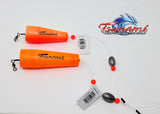Popping cork fishing techniques are not a new to anglers in states south of our shop for targeting redfish and sea trout. In the northeast, their popularity is pretty low. However, the techniques that work for redfish and sea trout also work for striped bass and weakfish. They can also be used to target fluke (summer flounder) in back bay shallow water.
The Tsunami Popping Cork consists of an approximate 24 inch heavy mono leader with barrel swivel at one end and a cupped foam float, some red plastic beads, and casting weight on the line. At the end is a snap for your lure.
We have these in 2 sizes, a 3 inch yellow cork with a ½ oz weight, and a 3 ¾ inch orange cork with a ¾ oz weight.
So how do these work? You cast the popping cork to a spot where fish are likely to be. Once the rig settles in the water, give the cork a quick pop or two. The commotion the popping cork makes will attract hungry or curious fish, who will then find your lure hanging below it. If after a few seconds there is not bite, repeat the popping.
What lures work with these? Soft plastics like jerk shads, kettle creeks, etc., Gulp! on a jig head, a Vudu shrimp are all popular choices.
Some tips:
- Make sure you pause between pops (or sets of pops) to let your lure settle back down. Many strikes come as the lure is slowly sinking after the pops. You do not need to work this like a popping plug.
- When casting this rig, a lob works much better than a snap cast. A snap cast will cause the lure and cork to spin in the air, shortening your casting distance and causing tangles.
- When fishing these, keep the line tight between the cork and your rod.
- Keep your rod tip low and pointed at the cork when fishing a popping cork. It will allow you to get a better hookset.
- Give the rod a good, sharp tug to create your pops. You want the noise to get the attention of predator fish.
WARNING: Cancer and Reproductive Harm- www.P65Warnings.ca.gov.







